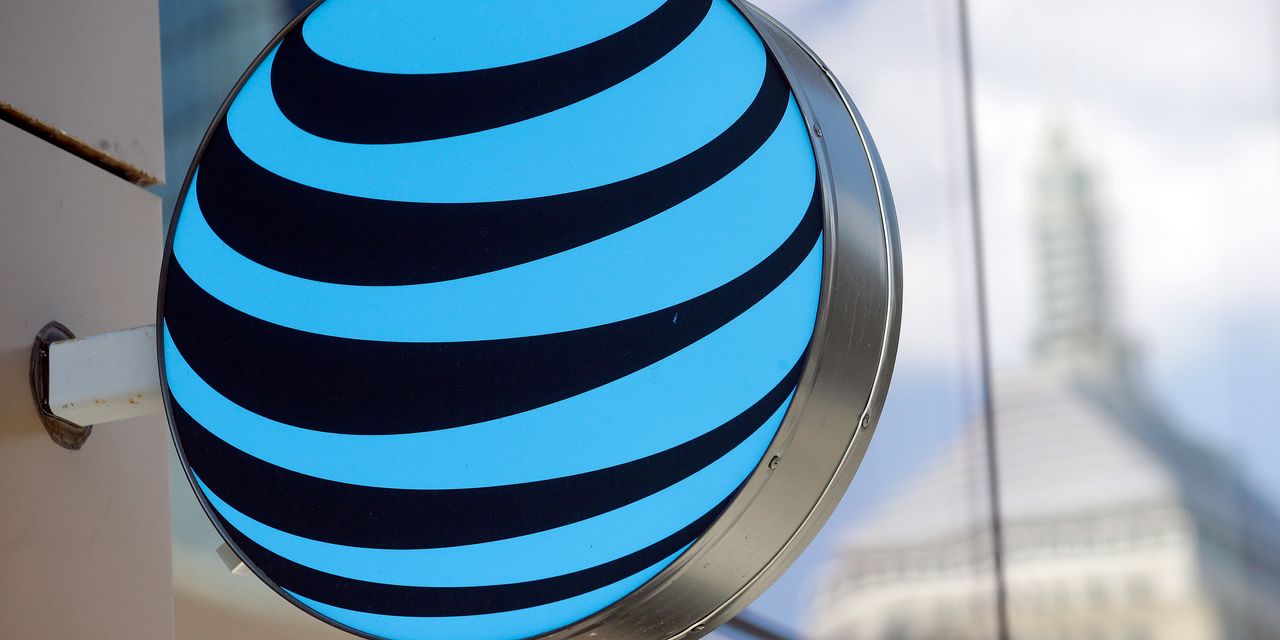AT&T shares were sinking Thursday despite an earnings beat in a quarter with a lot of moving parts due to recent business divestments.
While the company raised its annual forecast for mobility service revenue in light of stronger-than-expected customer additions, it also pulled down its free-cash-flow outlook to account for factors such as higher investment spending linked to customer growth and revised expectations around the timing of customer payments.
AT&T’s stock
T,
was oscillating between being on pace for its worst single-day percentage decline in two years and its worst such drop in more than two decades. Shares were down as much as 10.9% earlier in Thursday’s session, which would have been larger than the 10.2% drop sustained July 22, 2002 and second only to the 12.7% drop experienced Dec. 19, 2000.
The stock has bounced slightly from its intraday low and was recently off 8.9% in midday trading, putting it on track for its worst single-day fall since March 12, 2020, when it lost 9.2%.
AT&T said it saw the best second quarter for postpaid phone net additions in more than a decade as it delivered 813,000 adds during the latest period. Postpaid phone churn was 0.75%.
The company sees the subscriber momentum as indicative of efforts over the last two years to refocus on telecommunications through divestments of other businesses as well as investments in network enhancements. AT&T divested its video business in the third quarter of 2021 and spun off WarnerMedia in April.
“We’ve been listening to customers and what they want,” AT&T’s investor relations chief Amir Rozwadowski told MarketWatch. In recent quarters, the company has been offering deals for existing customers along with new customers, while its network has “gotten a lot better,” according to Rozwadowski.
The company now expects 4.5% to 5% growth in mobility service revenues for the full year. It had been expecting 3% growth or better when it outlined targets around its March investor day.
At the same time, AT&T acknowledged that its stronger-than-expected customer growth is one factor could impact free-cash flow for the year. The company now expects roughly $14 billion in 2022 free-cash flow, whereas its prior projection was for about $16 billion.
“If we have a promotion out there and do great sales, there is a cash cost associated with the device,” Rozwadowski said.
Edward Jones analyst Dave Heger explained that there is a lag between when subscribers buy devices from AT&T, sometimes at a discount, and when AT&T pays its suppliers for those devices. Therefore, in the wake of several strong quarters of subscriber growth, there is a “cash drag” as AT&T ultimately pays for the devices it provided customers.
Additionally, the current economic environment is having some effect on AT&T customers, another factor that contributes to the new free-cash-flow outlook.
“Customers are taking a bit more time to pay us,” Rozwadowski said. They’re “not not paying us,” something AT&T can see through its bad-debt-expense figure, and he doesn’t see them churning off the network either, but the trend could impact the timing of collections.
He added that the new outlook reflected “a little bit of a shift in cash-conversion expectations,” though the company wasn’t cutting its earnings forecast for the year.
Heger said that while AT&T’s results for the latest quarter were “relatively strong,” the lowered free-cash outlook seems to be spooking investors.
“Investors are pretty sensitive to free-cash flow for a company like AT&T, being a big dividend payer,” he said, though the new $14 billion outlook keeps the company in “good shape” as far as its dividend commitments, in his view.
AT&T’s operating revenue fell to $29.6 billion from $35.7 billion, while analysts were expecting $29.5 billion in revenue. AT&T divested its video business in the third quarter of 2021, so the company said that the drop in revenue reflects impacts to the year-earlier figure from that business and others that didn’t qualify as discontinued operations. The fall also reflects a decline in business wireless revenues, which was partly offset by higher revenue in the mobility segment.
Business wireline revenues fell to $5.60 billion from $6.05 billion, while analysts had been expecting $5.75 billion.
“Business wireline accounts for about 20% of revenues,” wrote MoffettNathanson’s Craig Moffett. “Trends are, well, putrid, and the segment is large enough to genuinely matter.”
Within the wireless business, AT&T highlighted pricing changes on legacy plans that could prompt more subscribers to opt for higher-end plans.
“We’ve been in an industry in the past several years where there’s been a lot of pricing declines for years and the value of services increased,” Rozwadowski. AT&T is “passing some on to customers” but those customers are “getting more bang for their buck,” he added, citing features including hotspot data.
Additionally, the company pointed to 316,000 AT&T Fiber net additions in its consumer-wireline business.
“The strength and value of the AT&T Fiber experience is enabling us to increase share in our fiber footprint and convert more…broadband internet subscribers to fiber subscribers,” Chief Executive John Stankey said on the earnings call, according to a FactSet transcript. “Ultimately, our fiber strategy is the sustainable and long-term technology play that will support key macro trends.”
The company posted net income of $4.1 billion, or 56 cents a share, compared with $1.5 billion, or 22 cents a share, in the year-earlier quarter, though the comparisons are messy considering the impacts from non-continuing operations in the year-ago results. AT&T shared that income from continuing operations came in at $4.8 billion, or 59 cents a share, compared with $6.0 billion, or 76 cents a share, a year before.
On an adjusted basis, AT&T earned 65 cents a share, down from 73 cents a share a year prior, but up from 64 cents a share on a standalone basis that focuses on continuing operations. The FactSet consensus for the latest quarter was for 61 cents a share.
Shares have dropped 7.8% over the past three months as the S&P 500
SPX,
has fallen 10.0%.
